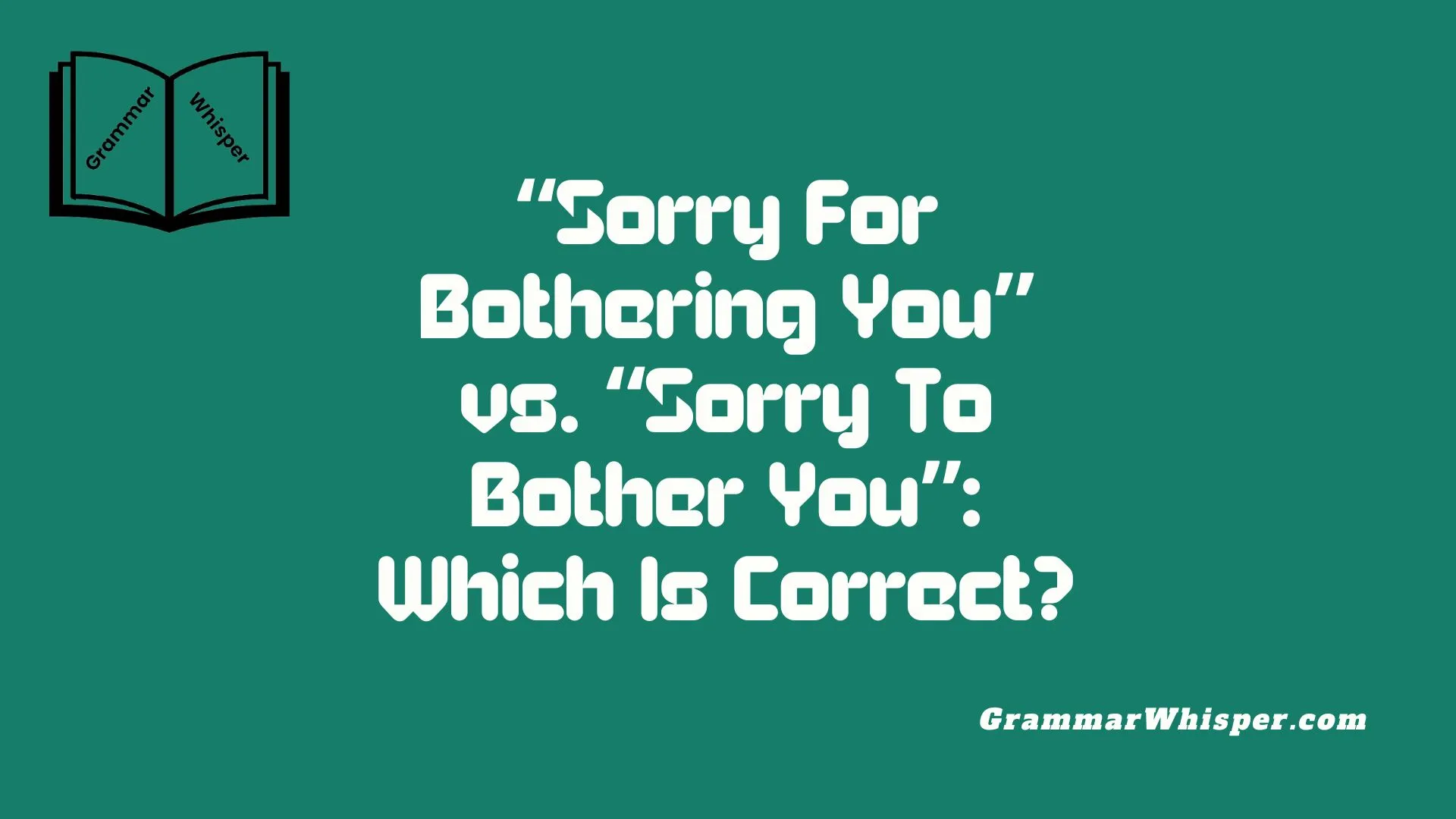When you say Sorry For Bothering You” vs. “Sorry To Bother You, you’re choosing common phrases in English that show polite apologizing. This simple art lets you connect with others during delicate situations, such as interrupting or inconveniencing someone. Though these phrases are quite similar, they hold subtle but important differences in tone, formality, and context. Knowing when to use each one can really improve your communication skills, whether you’re writing professional emails, chatting casually, or speaking across cross-cultural conversations.
This article shares practical examples and alternatives for various settings, guiding you on tailoring apologies to fit different audiences. Getting a clear understanding of the meanings and nuances behind these phrases gives you valuable insights into the cultural impacts that shape how we communicate respectfully and effectively worldwide. Choosing the right phrase at the right time helps your message feel more sincere and thoughtful, which can strengthen your relationships, both personally and professionally.
Clarifying the Meaning and Nuance of “Sorry For Bothering You” and “Sorry To Bother You”
Both phrases are apologies used before or after asking for someone’s attention. However, the slight variation in wording shapes how they are perceived.
- “Sorry to bother you” is generally more direct and immediate. It’s like saying, “I apologize before I interrupt or ask something.”
- “Sorry for bothering you” implies the action might already be ongoing or completed. It reflects awareness of inconvenience caused.
These differences might seem minor, but they impact the tone. “Sorry to bother you” sounds more formal and anticipatory, while “Sorry for bothering you” often feels softer and more empathetic.
Example:
- Before interrupting a colleague: “Sorry to bother you, but could you review this report?”
- After realizing you’ve kept someone longer than expected: “Sorry for bothering you earlier.”
Understanding these nuances allows you to express sincerity while matching the situation’s emotional tone.
Contextual Use in Communication
Apologies are not one-size-fits-all. The context determines which phrase fits best.
- Formal Settings: “Sorry to bother you” is preferred. It’s polite and anticipates disruption.
- Informal or Personal Settings: “Sorry for bothering you” can express empathy if you feel you have disturbed someone.
- Professional Emails: The first phrase is commonly used to open requests, showing respect for the recipient’s time.
Timing Matters: If you interrupt without warning, “Sorry to bother you” fits best. If you realize later that you have caused inconvenience, use “Sorry for bothering you.”
Table: When to Use Each Phrase
| Situation | Preferred Phrase | Why |
| Before asking a favor | Sorry to bother you | Anticipates and respects time |
| After unintentional intrusion | Sorry for bothering you | Acknowledges inconvenience |
| Casual chat with a friend | Either (context-dependent) | Depends on tone and closeness |
| Professional email introduction | Sorry to bother you | Maintains formality and respect |
Professional Communication: Writing Polite and Effective Emails
In workplace communication, how you apologize can set the tone for your message. Over-apologizing may weaken your authority, while under-apologizing can seem rude or careless.
Tips for Polite Email Apologies:
- Use “Sorry to bother you” when initiating contact, especially if the recipient is busy or senior.
- Follow with a clear, concise explanation of your request or reason for interruption.
- Avoid redundant apologies to maintain professionalism.
- End with gratitude to balance the tone.
Example:
Subject: Quick Question Regarding Project Timeline Email: Sorry to bother you, but could you clarify the deadline for the upcoming report? Thank you for your help.
Using this approach shows respect, clarity, and confidence.
Formality Spectrum: Tailoring Apologies for Different Audiences
Not everyone interprets apologies the same way. Adjust your phrasing based on:
- Relationship: Close friends might appreciate less formal apologies.
- Culture: Some cultures expect more frequent or formal apologies.
- Organizational Hierarchy: Higher-ranking officials may expect more formal language.
Practical Advice:
- When emailing a superior or client, default to “Sorry to bother you”.
- With teammates or peers, lighter phrases may suffice.
- Avoid over-apologizing in cultures that value directness, but be more tactful in high-context cultures like Japan or Korea.
When and How to Use “Sorry For Bothering You”
This phrase expresses empathy for the inconvenience caused. It’s especially useful when:
- You realize you may have overstayed your welcome.
- You want to acknowledge the recipient’s patience.
- The situation requires tact to maintain goodwill.
Psychological Impact: Using this phrase shows humility and respect, softening any negative feelings your request might trigger.
Example Use Cases:
- After a long phone call: “Sorry for bothering you so long.”
- When following up multiple times: “Sorry for bothering you again, but I wanted to check in.”
Alternatives to “Sorry To Bother You” for Casual and Friendly Settings
Sometimes, you want to apologize without sounding too formal or repetitive. Here are some casual, polite alternatives that work well in friendly or informal settings:
- “Hope I’m not bothering you.”
- “Just a quick question.”
- “I don’t want to interrupt, but…”
- “When you have a moment…”
- “Thanks for your time!”
Why Use Alternatives? They keep conversations light, reduce awkwardness, and avoid sounding overly apologetic.
Maintaining Sincerity Without Over-Apologizing
Apologizing too much can make you seem uncertain or diminish the value of your message. To strike the right balance:
- Apologize only when necessary.
- Combine your apology with a clear purpose.
- Use confident language alongside polite phrases.
Example: Instead of: “Sorry to bother you, but I don’t mean to be a pain…” Try: “Sorry to bother you. I just need a quick update on the project status.”
This approach conveys respect without undercutting your confidence.
Cultural Influences on Apologies: Navigating Global Communication
Apology customs vary widely worldwide. Here’s how culture shapes your phrase choice:
- Western cultures: Tend to use apologies freely and casually.
- East Asian cultures: Emphasize formality and humility in apologies.
- Middle Eastern cultures: May prefer indirect or nuanced apology expressions.
Tips for Multicultural Settings:
- Research your audience’s cultural norms.
- When in doubt, use more formal, respectful phrases.
- Watch for non-verbal cues that signal acceptance or discomfort.
Summary of Key Takeaways
| Aspect | “Sorry To Bother You” | “Sorry For Bothering You” | Alternatives & Tips |
| Tone | Formal, anticipatory | Empathetic, reflective | Casual: “Hope I’m not bothering you” |
| Best Use | Before asking or interrupting | After inconvenience | Use based on context and relationship |
| Professional Suitability | High | Medium | Use polite, concise language in emails |
| Cultural Sensitivity | Generally safe | Shows humility | Adapt for audience culture |
| Avoid Over-Apologizing | Yes | Yes | Apologize only when necessary |
Mastering these subtle differences enhances your ability to communicate respectfully and clearly. Using the right phrase at the right time builds goodwill and professionalism, whether you’re emailing a colleague or chatting with a friend.
Final Thoughts
Understanding the difference between “Sorry for bothering you” and “Sorry to bother you” goes beyond just grammar – it’s about mastering polite communication that respects others’ time and feelings. Using these phrases appropriately helps you sound sincere, professional, and considerate, whether in emails, conversations, or multicultural settings.
Remember, the goal isn’t to apologize endlessly but to express your message clearly and kindly. Tailoring your tone to fit your audience and situation makes all the difference. When you strike this balance, you foster better relationships, avoid misunderstandings, and create a positive impression every time you communicate.
FAQs
What is the main difference between “Sorry for bothering you” and “Sorry to bother you”?
“Sorry to bother you” is usually used before interrupting or asking for help, showing politeness upfront. “Sorry for bothering you” often reflects regret after realizing you might have inconvenienced someone.
Can I use these phrases interchangeably?
While similar, they are not always interchangeable. Use “Sorry to bother you” when initiating contact and “Sorry for bothering you” to acknowledge past inconvenience.
Are there more casual alternatives to these apologies?
Yes! Phrases like “Hope I’m not bothering you,” “Just a quick question,” or “Thanks for your time” work well in informal situations without sounding too formal.
How do cultural differences affect the use of these apologies?
Cultural norms shape how apologies are perceived. For example, East Asian cultures often prefer more formal and humble expressions, while Western cultures use apologies more freely. Adjust your language to respect these differences.
Is it possible to over-apologize?
Absolutely. Over-apologizing can weaken your message and make you appear uncertain. Apologize thoughtfully and confidently, combining it with a clear purpose to maintain professionalism.











